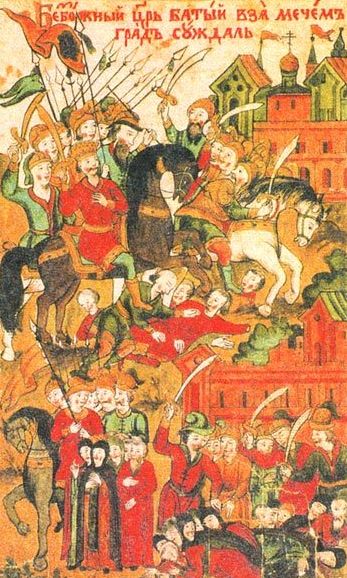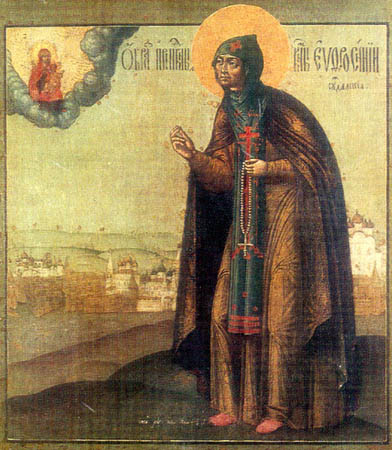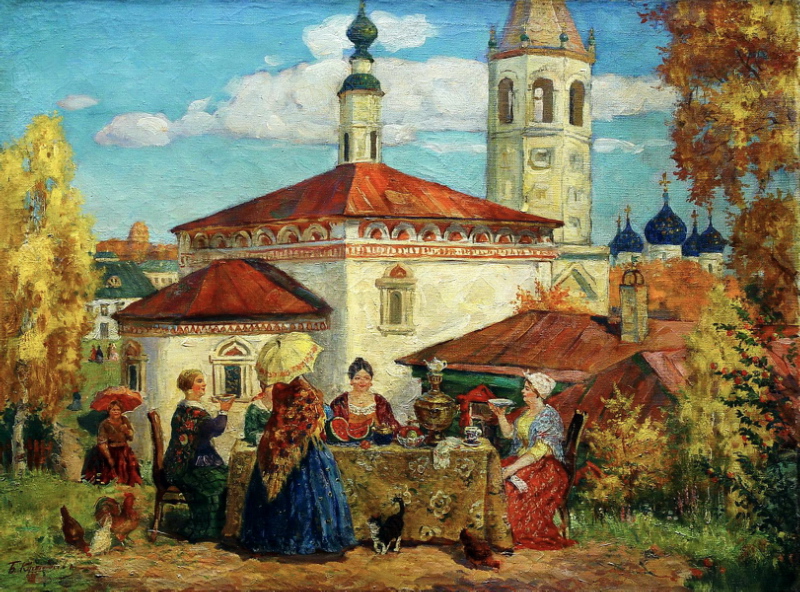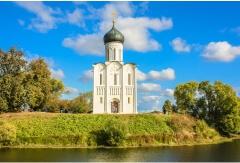History of Suzdal
11th Century
First Mention
The first mention of Suzdal in chronicles came in 1024 in relation to an uprising of Volkhvy (Slavic druids) in Suzdal lands in response to a crop failure and drought. Grand Prince Yaroslav the Wise was forced to intervene to end the rebellion. This date has since been used as the official date of foundation of Suzdal, although as Suzdal was already in existence in 1024 it must have been founded sometime earlier. Some historians claim there is an even older mention of the city, which would mean the first mention came in 999.
12th Century
Rostov-Suzdal Principality
In 1125 Prince Yuri Dolgoruky of Rostov moved his capital from Rostov Veliky to Suzdal and his principality became known as the Rostov-Suzdal Principality. During Yuri Dolgoruky's reign the defences of the Suzdal Kremlin were erected and the original version of the Nativity of Virgin Mary Cathedral was built within the kremlin. In 1157 the capital of the principality was once more moved, this time to Vladimir by Yuri Dolgoruky's son Andrey Bogolyubsky. The principality became known as the Vladimir Grand Principality, and Suzdal remained a part of it for the rest of the century.
13th Century
Suzdal Principality

In 1238 Suzdal shared the fate of many other Russian cities when it was conquered and sacked by the Mongol-Tatars during their invasion of Rus. After the invasion, Grand Prince Yaroslav Vsevolodovich of Vladimir granted his brother Svyatoslav Vsevolodovich Suzdal as an appendage. In 1246 Svyatoslav himself became Grand Prince of Vladimir and the Suzdal Principality was re-incorporated. It was created once more in 1256 when Grand Prince Aleksandr Nevsky granted it to his brother Andrey upon making peace with him. The principality included the cities of Nizhny Novgorod and Gorodets. Andrey Yaroslavich became the founder of the Suzdal dynasty of Ryurikids, later known as the Shuiskys. After Andrey's death in 1264 he was succeeded in Suzdal by his three sons Yuri (1264-1279), Mikhail (1279-1305) and Vasili (1305-1309).
14th Century
Suzdal-Nizhny Novgorod Grand Principality
Vasili Andreevich was followed as prince of Suzdal by his son Aleksandr in 1309. Aleksandr Vasilievich became grand prince of Vladimir in 1328 although he remained based in Suzdal. When he died in 1331 Suzdal was inherited by his brother Konstantin Vasilievich whereas the Vladimir Grand Principality, including Nizhny Novgorod and Gorodets, was granted to Ivan Kalita of Moscow. In 1341 Konstantin Vasilievich of Suzdal was granted Nizhny Novgorod and Gorodets by Khan Uzhek upon the death of Ivan Kalita. The principality was reorganised as the Suzdal-Nizhny Novgorod Grand Principality. In 1350 Nizhny Novgorod replaced Suzdal as the capital of the principality.
St Euthymius of Suzdal

In 1352 the monk Yevfimi from Nizhny Novgorod was invited by Prince Boris Konstantinovich, son Grand Principality Konstantin Vasilievich of Suzdal-Nizhny Novgorod, to Suzdal in order to found a monastery there. Yevfimi founded the Spassy Monastery in the north of the city near the River Kamenka and served as its first archimandrite until his death in 1404. Later the monastery was renamed in honour of its founder as the Spaso-Yevfimiev Monastery. Yevfimi himself was eventually canonised as St Euthymius (Yevfimi) of Suzdal.
Prince Dmitri Konstantinovich of Suzdal
In 1355 Konstantin Vasilievich died. Just before his death he sent his younger sons Dmitri and Boris to Suzdal and Gorodets respectively, while his eldest son Andrey Konstantinovich became grand prince of Suzdal-Nizhny Novgorod. Prince Dmitri Konstantinovich of Suzdal set out a policy of opposing Moscow for the title of Grand Prince of Vladimir which he held briefly from 1360 to 1362. Dmitri Konstantinovich achieved more success in 1365 with the Suzdal-Nizhny Novgorod Grand Principality which he inherited upon the death of his older brother Andrey despite the attempts of his younger brother Boris to seize the throne. The dispute between the brothers was only resolved with the intervention of St Sergius of Radonezh. Dmitri Konstantinovich ruled as Grand Prince of Suzdal-Nizhny Novgorod until his death in 1383.
Grand Prince Boris Konstantinovich of Suzdal-Nizhny Novgorod
After Dmitri Konstantinovich's death, his younger brother Boris Konstantinovich finally became Grand Prince of Suzdal-Nizhny Novgorod. However over the next decades he struggled with his two nephews, Semyon Dmitievich and Vasili Dmitrievich Kirdyapa, for control of Nizhny Novgorod, Suzdal and Gorodets. His position was secured as grand prince in 1390 when the khan granted him a new yarlyk (patent) to rule there. But this security did not last long as in approximately 1392 Vasili I of Moscow managed to buy from the khan the yarlyk to rule the Suzdal-Nizhny Novgorod Grand Principality. Upon hearing the news the discontent citizens of the principality expelled their princes and Vasili installed viceroys in the major cities and merged the principality into the Moscow Grand Principality. Boris Konstantinovich later died in captivity in Suzdal in approximately 1393.
15th Century
Battle of Suzdal
In 1445 Suzdal was the scene of the Battle of Suzdal which was fought under the walls of the monastery between Russian troops led by Grand Prince Vasili II of Moscow and Tatar troops from the Kazan Khanate. In the battle the Kazan Tatars were victorious and Vasili II was even taken prisoner. He was only released when an enormous ransom was paid.
16th Century
Royal Place of Exile

In the 16th century Suzdal became a religious centre of Russia with 11 monasteries and convents which underwent new stone construction work. In 1525 Grand Prince Vasili III's first wife, Solomonia Saburova, was forced to become a nun so that Vasili was free to remarry and finally gain a male heir. Solomonia eventually settled in Suzdal's Pokrovsky Convent where she died in 1542. She was later canonised as St Sofia of Suzdal, as she took the name Sofia upon becoming a nun. A legend exists that upon arriving at the monastery Solomnia gave birth to Kudeyar, a legendary robber who features in Russia folk stories. It is also said she cursed her former husband which was fulfilled by his long-awaited heir being Ivan the Terrible. Tsarevich Ivan Ivanovich followed his grandfather's lead by exiling to the Pokrovsky Convent his first wife Yevdokia Saburova (Solomnia's niece) in 1572 and his second wife Feodosia Solovaya in 1579 for failing to produce an heir.
17th Century
Time of Troubles
The Time of Troubles brought much destruction to Suzdal throughout the years of 1608 to 1612, during which time the city was sacked by Polish-Lithuanian Interventionists. During the reign of Tsar Vasili Shuisky the city pledged its allegiance to the Second False Dmitri whose supporters occupied the city. More destruction came after the Troubles had ended as the city was raided in 1634 by Crimean Tatars and then plague struck the city in 1654 and 1655.
18th Century
Administrative Reforms
In 1708, during the administrative reforms of Peter the Great, Suzdal became part of the Moscow Governorate and in 1719 it became the centre of the Suzdal Province of the Moscow Governorate. In the same year a fire broke out in the Suzdal Kremlin destroying practically all of its wooden structures. In 1766 Catherine the Great established a prison in the which over the next two centuries would be used to incarcerate many prisoners on political and religious grounds. In 1778 Suzdal was granted city status and it became the centre of the Suzdal District of the newly created Vladimir Viceroyalty which later became the Vladimir Governorate. Around this time a coat of arms was adopted for the city which features a crowned falcon on a blue and red background.
19th Century
Decline

Throughout the 18th century Suzdal experienced economic decline and it became a remote provincial city. This was partly brought about by the fact that no railway line was constructed in Suzdal (this still is the case today), which in turn mean that no major industry was developed in the city. The Spaso-Yevfimiev Monastery's prison continued to be used by the authorities. Famous prisoners during the 18th century included the Decembrist Fyodor Shakhovsky, the seer Avel, the leader of the Molokan sect Maksim Rudomyotkin, as well as several leading Old-Believers.
20th Century
Development of Tourism

After the revolution the majority of Suzdal's churches and monasteries were closed down. The prison at the Spaso-Yevfimiev Monastery was put to good use by the Bolsheviks who extended it and used it for political prisoners. During the war it was used to hold POWs especially Italian POWs. In 1958 the Vladimir-Suzdal Museum-Reserve was established which included many buildings in Suzdal. In 1967 a plan was adopted to make use of the fact that Suzdal was left untouched by industry by developing the city as an open air museum. In 1968 the Spaso-Yevfimiev Monastery was transferred to the Vladimir-Suzdal Museum-Reserve and subsequently restored.

In the 1990s four of Suzdal's five monasteries/convents were returned to the Russian Orthodox Church; however the Spaso-Yevfimiev Monastery still remains part of the Vladimir-Suzdal Museum-Reserve. In 1992 Suzdal's Spaso-Yevfimiev Monastery, Kremlin and Nativity of the Virgin Mary Cathedral were inscribed on UNESCO's World Heritage List as part of the White Monuments of Vladimir and Suzdal.


 History
History